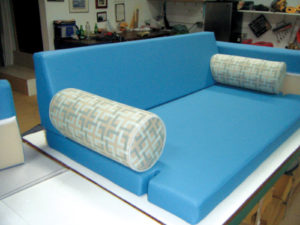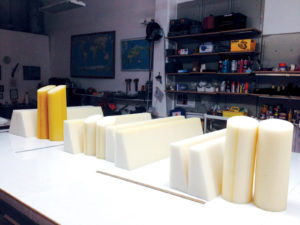
From cockpit cushions with hull angles to bosun’s chairs and boat mattresses, choosing the best solution for cushion foam is a bit of a science. The task can feel daunting given the complexity of choices in foam types, materials, densities and compression factors, but choosing correctly is crucial to a project’s success.
Factor in comfort
When choosing foam for your cushion project, you generally need a balance of comfort, support and durability that is appropriate for your application. I recommend you have different foam samples on hand so your customers can evaluate their preferences during “sit tests.” This is especially valuable when working on custom projects.
Support: The thickness of the foam will affect its ability to support weight. Consider the weight of the person being supported. A larger person (more than 250 pounds) will need firmer foam.
Comfort: The softer the foam, the more comfortable it will be. Adding a Dacron® fiberfill wrap topper is an excellent way to add a bit of comfort while still having a good supportive foam. The fiberfill also helps in “filling out” the sides and edges of a firm foam inside the cushion covers. Since fiberfill compresses easily, cut your foam to size without compensating for the fiberfill; otherwise, you’ll end up with a boat cushion that has a baggy appearance.
Durability: Higher density foams have a much higher resistance to collapsing or bottoming out than lower density, inexpensive foams. Applications in which a cushion is used onboard a vessel should lean toward a higher density. Seating that is used only occasionally could use a lower density foam.
Open-cell foam
Open-cell foam is characterized as a soft material. The surfaces of the bubbles (the cells) are broken and interconnected so that air moves easily through all the spaces of the material when the foam is squeezed or compressed.
Open-cell foam types and uses:
- Polyurethane foam is the lowest quality of foam and will often not return to its original form.
- High-density foam is sold primarily for mattresses, average sofa and chair cushions, interior boat cushions and camping pads. Some vendors offer high-density foam (also called high resilient foam) used in expensive seating, including yachting and boating, because it is very buoyant and resilient.
- Memory foam, also known as miracle foam, wonder foam or viscoelastic foam, has additional chemicals that increase its viscosity and density. It is often used as extra padding atop a mattress as it is soft, comfortable and compacts rapidly as it conforms to a shape. Developed for space shuttle seating, it is used for mattresses and is the most unique foam currently on the market.
- Latex rubber foam is a non-allergenic foam. It was the first type of foam on the market and the longest lasting. It is used in top-of-the-line products including mattresses and cushions. It’s of better quality than high-density foam.
- Rebond foam is highly resilient and stands up to high impact usage.
- Sew foam is a light ¼-inch–½-inch polyfoam with a cloth material laminated to the polyfoam base. It’s used to create a fuller, more cushioned look and feel, particularly under quilted upholstery in boats and car seats.
- Shredded foam can be used in throw pillows, cushions, patio furniture and cushion backs. It is available in regular shredded foam and shredded memory foam.
- Dryfast foam, also known as outdoor foam, marine foam and open-cell foam, is highly recommended for outdoor use where moisture and water is prevalent. It does not absorb moisture like conventional foams and is widely used for boat cushions, boat mattresses and patio furniture. The large, open cells of Dryfast foam provide a degree of airflow not present in other foams, allowing it to dry quickly, even after complete saturation. It is antimicrobial and helps suppress microorganism growth common in damp areas.
Overall, open-cell foam is recommended for cushioning, padding and backing for furniture when you are looking for a balance of comfort and support. It’s also useful for occasional bedding products and is generally available at an affordable price in standard sizes and heights as well as cylinders and wedges. Polyurethane foam, memory foam and latex foam are the three most common types of open-cell foam.
Closed-cell foam
Closed-cell foam is generally much denser and firmer than open-cell foam. Its air bubbles are completely sealed (closed) off from those around it. These materials typically have higher compressive strength because the air does not dissipate when the foam is squeezed or pressed.
Closed-cell foam types and uses:
- Polyethylene foam is very rigid, but has excellent buoyancy and is typically used in flotation equipment and other nautical products.
- Everflo EVA foam (ethylene-vinyl acetate) is a UV-resistant closed-cell foam that is very firm, yet has a soft rubbery feel.
- FloTex foam is not UV-resistant, but it is often used for boat and yoga mats as it has a squishy texture.
- Neoprene foam is a flexible, form-fitting and durable sponge rubber that provides good thermal and moisture insulation. It resists ozone, sunlight, oxidation and many petroleum derivatives and chemicals.
- Additional closed-cell foams include: crosslinked polyethylene, polystyrene, gym rubber, polypropylene and Volara (polyolefin).
- Closed-cell foam is often used in flotation equipment and marine products because it does not soak up water. It’s also resistant to solvents, petroleum products and has antimicrobial properties to prevent the growth of mold and mildew.

Density and Compression
Density and firmness are two important measurements of foam quality. Different foam manufacturers may use different numbering or rating systems. In the common four-digit system, the first two digits specify the density of the foam and the second two digits specify the compression (firmness) of the foam. Firmness is measured in terms of ILD (Indention Load Deflection), also sometimes referred to as IFD (Indention Force Deflection).
Density technically means taking a solid chunk of 12 x 12 x 12-inch foam and weighing it in pounds. The denser the foam, the more resilient and durable it will be. Upholstery foam is rated in density by a 2-digit number ranging from 18 to 35 with a decimal point between the 2 numbers. A #18 foam would be 1.8 foam. Some usage guidelines:
1.8 (extra soft, used as back cushions)
2.4 (comfortable soft,
firmer back cushions)
2.7 (soft, soft seat but firm back cushions)
2.7 (medium, medium seat)
2.8 (medium soft, medium soft seat)
1.9 (medium firm)
2.8 (firm, typically a 2-inch
thick dining room chair)
3.2 (extra firm)
Compression (firmness) is an ILD/IFD value represented by how many pounds it takes to compress the foam by 25 percent. A higher number means firmer foam and a lower number means softer foam.
Making the decision
Cost will obviously be an important factor in your choice. The price for upholstery foam is based on sheets of a specific size and weight as well as density. Some vendors will offer custom cutting and pricing for upholstery foam if you don’t need the large pieces they normally sell. (Expect the price to be slightly higher per square foot than if you’d bought it in larger sheets and then cut it yourself.) Upholstery foam can range from $12 a sheet (sold in 24 x 24 x 2-inch sections) to more than $126 a sheet (sold in 6 x 24 x 84-inch sections).
Some states have flammability laws that may lock you into using foam rated as fire-resistant. Check with local and national suppliers for these requirements as well as samples, sizes, custom cutting options and pricing.
Ultimately, the “perfect” cushion foam for a given project depends on the primary use of the piece you’re fabricating. Understanding an application’s requirements and your customers’ expectations is the best way to determine the best foam choice among the wide variety of options available.
Terri Madden owns Sand Sea and Air Interiors Inc. in San Juan, Puerto Rico. www.sandseaair.com.
Foam is essentially a group of air bubbles trapped inside a solid matrix. Open-cell foam is characterized as a soft material and is ideal for cushioning, padding and backing for furniture. Closed-cell foam—generally much denser and firmer than open-cell foam—is often used in flotation equipment and marine products.
 TEXTILES.ORG
TEXTILES.ORG


